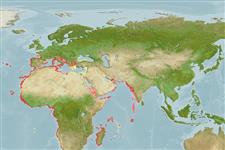Classification / Names
Common names from other countries
Main reference
Size / Weight / Age
Max length : 200 cm TL male/unsexed; (Ref. 57392); common length : 100.0 cm TL male/unsexed; (Ref. 3197); max. published weight: 50.0 kg (Ref. 27584)
Length at first maturity
Lm ?, range 60 - ? cm
Environment
Marine; brackish; pelagic-neritic; oceanodromous (Ref. 51243); depth range 0 - 50 m (Ref. 3197)
Climate / Range
Subtropical, preferred 26°C (Ref. 107945); 47°N - 28°S
Distribution
Eastern Atlantic: southern Bay of Biscay to South Africa, including the Mediterranean. Western Indian Ocean: South Africa to Delagoa Bay, Lourenço Marques.
Countries | FAO areas | Ecosystems | Occurrences | Introductions
Short description
Dorsal
spines
(total): 8;
Dorsal
soft rays
(total): 19-21;
Anal
spines: 3;
Anal
soft rays: 17 - 21. Diagnosis: body elongate, moderately deep and compressed; dorsal profile of head almost straight, ending in a pointed snout; eyes relatively small; upper jaw slender and rounded posteriorly, ending below or beyond posterior eye margin; 2 dorsal fins, 1st with 7 spines with only their bases connected by a membrane, 2nd with 1 spine and 19-21 soft rays; anal fin with 2 detached spines followed by 1 spine and 17-21 soft rays; pectoral fins short, comprised 1.5-1.8 times in head length; scales small, those on breast oval to strongly lanceolate, and partially embedded in the skin; lateral line very irregular and wavy, describing a convex curve over, and a concave curve behind pectoral fins; no lateral-line scutes (Ref. 57392). Brown above, silvery white below lateral line; lobes of dorsal and anal fins black distally; juveniles (to at least 12 cm fork length) with brownish black bars on sides (Ref. 3197, 57392).
IUCN Red List Status (Ref. 115185)
Threat to humans
Harmless
Human uses
Fisheries: commercial; gamefish: yes
Tools
Special reports
Download XML
Internet sources
Estimates of some properties based on models
Phylogenetic diversity index
PD50 = 1.0000 many relatives (e.g. carps) 0.5 - 2.0 few relatives (e.g. lungfishes)
Trophic Level
4.5 ±0.8 se; Based on diet studies.
Resilience
Medium, minimum population doubling time 1.4 - 4.4 years (Assuming tm=2)
Vulnerability
High to very high vulnerability (75 of 100)
Price category
